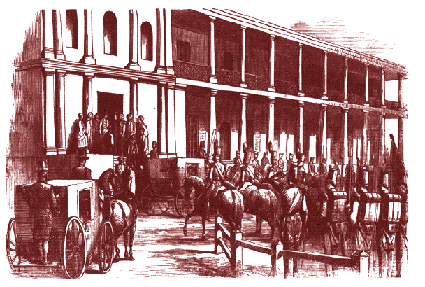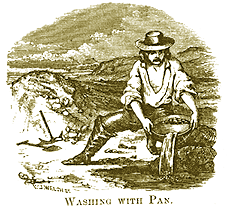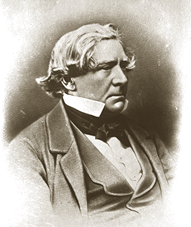First Elected Legislative Council, 1843

The enlarged Legislative Council of 1843 consisted of 36 members, 24 of whom were elected at the first elections ever to take place in Australia. Fortunately, most elections since that one have been peaceful and orderly; however, the first one resulted in several violent incidents, including a massed attack on the polling booth on Sydney's Observatory Hill which resulted in the Riot Act being read and at least one fatality.
The new Council had a new Council Chamber built for it, on the northern end of the old Rum Hospital Building now mostly used by the Legislature. This Chamber, modified and enlarged, remains in use today since 1856, housing the Legislative Assembly. It is the oldest legislative chamber in Australia and probably the second longest in constant use throughout the Commonwealth of Nations.
The House's first Speaker was Alexander Macleay, whose Elizabeth Bay House is a Historic Houses Trust property open to the public today. The Speaker was paid, making him the first salaried Parliamentary Member in New South Wales.
Although New South Wales now had a representative form of government, the Governor still had more power than the Council. If the Council proposed a bill with which the Governor disagreed, the Council could be dissolved and the bill referred to the British government. This was, of course, an excellent delaying tactic. Nevertheless, the period from 1843 to 1856 was an important stage in democratic development as the expanded and partially elected Legislative Council discussed and generated further discussion of the issues of government. Political parties did not exist at this stage; Councillors tended to align on specific issues and vote according to their particular interests or philosophies.
New South Wales in 1852
By 1843, New South Wales was no longer a convict colony. No convicts had been sent from Britain since 1840 and convicts or even former convicts were very much in the minority of the population. In 1849, the British government had attempted to revive transportation of convicts to New South Wales and, in June 1849, the arrival of the convict transport Hashemy provoked large demonstrations in Sydney and the formation of an anti-transportation league. In 1850, the Legislative Council called on the British Government to end transportation permanently and, in fact, no more ships arrived in Sydney after the Hashemy. It was the first major statement of popular political independence from Britain and an indication that the "squattocracy" was starting to lose its political dominance.
Some of the landowners of the Patriotic Association, including William Charles Wentworth, advocated the resumption of transportation as a cheap solution to their labour problems and resisted radical political change. However, free and assisted immigration was growing, adding to the workforce and the demand for improved representation in government. In 1850, the few thousand convicts left in NSW made up barely 2% of the population, whereas in the 3 years between 1848 and 1850, 62,000 free immigrants arrived from Britain. Australia was already being represented as a "working man's paradise".
In 1850, the district of Port Phillip was separated from New South Wales to become the colony of Victoria. Van Dieman's Land (called Tasmania from 1856 onwards) had been separated from New South Wales since 1825. The colony of South Australia had been separate from the time of its first settlement by Europeans in 1836. The last section of New South Wales to be separated was the District of Moreton Bay which became the colony of Queensland in 1859.
Construction began in Sydney on the first Australian railway in 1850 - although it was 5 years before it reached Parramatta, 20 kilometres away (by which time another railway had opened in Victoria). Taken in conjunction with the electric telegraph, which linked the major eastern cities of Australia by the end of the 1850s, and the arrival of the first England to Australia steamship in Sydney in 1852, it heralded the opening of a new age of communication which would have enormous economic, social and political consequences and link the colonies more closely both with each other and the rest of the world.
The Gold Rushes Begin, 1851

The most dramatic impact on New South Wales came from the discovery of gold in May 1851. The discovery reversed the exodus to the Californian goldfields after 1849, and brought, instead, a sudden and enormous influx of population to the Australian colonies. After the separation of Victoria in 1851, the population of New South Wales was 187,000. By 1860 it had almost doubled to 348,000, even after the colony of Queensland had been separated from New South Wales in 1859.
While some of the newcomers left the colony again with or without their hoped-for riches, most stayed and settled in the cities or countryside.
There were problems, however, as the miners on the sprawling goldfields resented authoritarian attempts to impose licences and other controls on their activities. The miners had no proper representation in the Legislature, and their growing demands for democratic government could not be ignored. At the same time, the arrival of large numbers of Chinese miners led to racial violence and demands for governments to control non-white immigration. Enormous economic changes followed - initially in the mining and export of gold - which transformed the economy. Some 3,280,969 ounces of gold were produced in NSW between 1851 and 60. The longer term impacts included increasing urban development and industrialisation funded by newly generated capital.
Labour shortages in the cities during the gold rushes drove the wages and conditions of workmen well above those of the rest of the world. As miners left the fields, there was rapid urban growth, and housing booms were fuelled again by goldfields capital. In the countryside, there was a growing demand to "unlock the lands" for free selection of small holdings, to break up the great runs of the squatters, who had dominated politics before the gold rushes.
Along with demands for liberal political change from the affluent and confident middle and working classes, came demands for similar progress in education, trade, public works and transport, and free selection.
Gaining Responsible Government
 The remarkable William Charles Wentworth (1790-1872),
The remarkable William Charles Wentworth (1790-1872),
born on board a convict ship of a convict mother and a surgeon father.
He was in the first European party to cross the Blue Mountains west of Sydney; became a lawyer, poet, proprietor of Australia's first free newspaper, wealthy landowner, advocate for self-government and all things Australian and, in the 1850s, "father" of the new New South Wales Constitution.
In 1850 the Australian Colonies Government Act was passed by the British Parliament. It expanded the Legislative Council so that by 1851 there were now 54 members - again, with two-thirds elected. The Act also permitted the creation of three other self-governing colonies with a Legislative Council on the New South Wales model: South Australia, Tasmania, and Victoria.
In 1853 a select committee chaired by William Charles Wentworth began drafting a constitution for responsible self-government for New South Wales. The Committee’s proposed Constitution Act was placed before the Legislative Council in August that year and, on the whole, accepted. Not accepted were proposals for a Lower House electoral distribution which would heavily favour the country and squatting interests, and an Upper House of Hereditary Peers, like the English House of Lords. The latter idea was particularly derided by the orator Daniel Henry Deniehy as a proposal for a "bunyip aristocracy". The revised Constitution Act, with an Upper House whose Members were appointed for life, was sent to the British Parliament and, with some further amendments, was passed into law on 16 July 1855.
